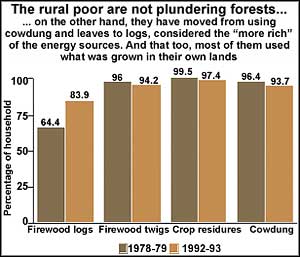The rural poor are not plundering forests...
The rural poor are not plundering forests...

In 1978-79 , a third of the households were purchasing firewood logs. But in 1992-93, just about one-sixth were doing so. These are the findings of a nationwide survey, conducted by the New Delhi-based National Council of Applied Economic Researh. Undoubtedly, the survey has raised innumerable questions about the long held perceptions about rural firewood consumption, and its impact on the country's environment.
A major factor for this transition appears to be the success of farm forestry programmes, thus ensuring self-sufficiency in meeting firewood needs. Between 1980 and 1988, an estimated 18 billion trees were planted, 10 billion on farmlands. Assuming that 5 billion of these survived, it would have given about 25 million tonnes of wood annually compared to the 10 million tonnes that is provided legally as firewood by all the country's forests.
The most surprising finding was that even as the share of fuelwood went up in rural household energy consumption, people used more superior biomass fuel in 1992-93 as compared to 1978-79. They were moving up the energy ladder by using higher quality fuel like logs instead of twigs, cowdung, crop residues or even leaves.
When firewood availability becomes difficult, studies from various parts of the world show that rural people tend to switch from using logs to little twigs and branches. And when even these are not available, they use crop residues, cowdung and dry leaves. In Midnapore and Purulia districts of West Bengal, for instance, when firewood availability was extremely scarce in the mid-1980s, rural women collected leaves of Acacia auriculiformis (Australian wattle) to use as fuel.
According to the National Council of Applied Economic Research survey, in 1992-93, not only did the share of cowdung and crop residues go down as compared to 1978-79, the share of firewood in the form of twigs also fell from 35.62 per cent to 29.11 per cent. However, the share of firewood in the form of logs increased from 18.95 per cent to 32.49 per cent. In other words, what was often described as a "rural energy crisis' in the 1970s and 1980s had begun to ease by the early 1990s. The choice also explains the affordability and availability of the "more expensive' fuel in rural India.
Flora for fuelwood
One of the factors that has contributed to increased firewood supply is the invasion of Prosopis juliflora . It has invaded public lands and has been grown along roadsides, especially in the dry regions. It is found in almost all districts of Uttar Pradesh, Haryana and Punjab; select districts of Gujarat; Bangalore, Tumkur and Kolar districts of Karnataka; and, Midnapore, Bankura and Purulia districts of West Bengal.







